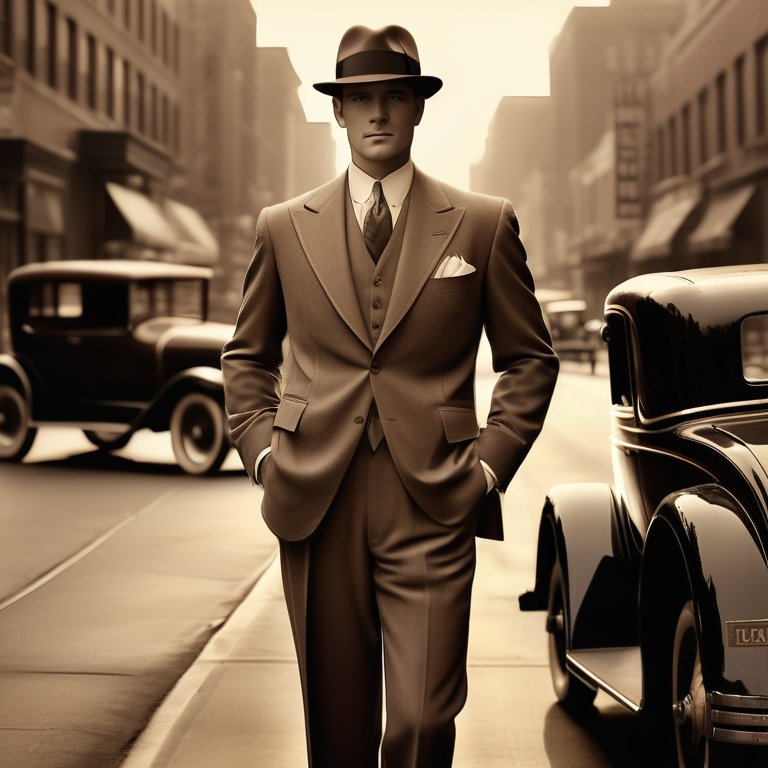
| Garment | Key Design Elements | Style Role |
| Men’s Fedora Hats | Creased crown, front pinch, adaptable brim styles | Adds structure and personality to outfits |
| Men’s Walking Suits | Coordinated top and trousers, soft tailoring | Balances casual ease with cohesive styling |
How the Fedora Became a Cultural Icon
The fedora is more than a simple hat — it’s a piece of history. Originally associated with formal dress codes, it gained prominence in the early 20th century as both a fashion statement and a practical choice. Its wide brim offered protection from the elements, while the distinctive crown and crease lines gave it a structured elegance that suited both city and country life.
By the 1950s, the fedora was everywhere — in newsrooms, on film sets, and in jazz clubs. Over time, it became a symbol of individuality, adopted by artists, travelers, and modern professionals who valued its timeless silhouette.
Walking Suits and Their Easy Coordination
Walking suits emerged as a clever style solution in mid-century menswear. Instead of pairing separate garments, these matching sets provided an instant, well-put-together appearance. The design typically includes a short-sleeved or long-sleeved top paired with trousers of the same fabric, making it ideal for relaxed settings that still demand a degree of refinement.
Unlike traditional suits, walking suits favor comfort and movement, often using lighter fabrics and looser cuts. They can be worn for informal gatherings, weekend outings, or even as travel attire, making them a versatile option in any man’s wardrobe.
Selecting the Right Fedora for Your Look
Not all fedoras are created equal, and the right choice depends on your face shape, build, and personal style. Wider brims can create a bold statement, but may overpower slimmer frames. Narrower brims offer a subtler profile and work well for most everyday occasions.
Material matters too — felt fedoras are perfect for colder months, while lightweight straw styles suit spring and summer. For a dependable starting point, mens fedora hats in neutral tones like navy, black, or taupe adapt easily to multiple outfits.
Dressing a Walking Suit Up or Down
The walking suit’s strength lies in its adaptability. For a casual approach, it can be paired with loafers or clean sneakers and minimal accessories. To create a more polished effect, opt for dress shoes, a coordinating belt, and a neatly pressed finish.
Layering also changes the tone. Adding a light jacket or blazer instantly elevates the look, while pairing the suit with a plain t-shirt keeps it weekend-ready.
Styling scenarios:
● Resort wear: Lightweight fabric, open collar, sandals or espadrilles.
● City day out: Closed collar, leather loafers, slim belt.
● Evening gathering: Darker tones, polished shoes, minimal jewelry.
Seasonal Transitions and the Fedora
One reason the fedora has lasted is its ability to adapt to the seasons. A felt fedora pairs naturally with coats, knit scarves, and gloves during winter. In summer, a straw fedora with a lighter crown structure provides airflow while protecting from the sun.
Color shifts can also support seasonal styling. Deep, rich tones suit autumn and winter wardrobes, while sandy beige, off-white, or pale gray work beautifully for spring and summer events.
Fabric Choices in Walking Suits
Walking suits have always been about comfort, and fabric selection is key. Linen and cotton remain favorites for warm climates, allowing the skin to breathe. For cooler days, blends with wool or heavier cotton create warmth without compromising mobility.
Modern tailoring has introduced a range of mens walking suits that incorporate stretch fibers, making them even more practical for day-long wear. The best walking suits achieve a balance between drape and structure, ensuring they look sharp without feeling restrictive.
Famous Moments in Style
From classic film stars stepping out in their signature fedoras to street photography capturing the relaxed elegance of walking suits, both garments have appeared in countless style moments. The fedora’s film noir associations give it a certain mystique, while walking suits have been immortalized in images of 1960s leisure culture.
Today, both are regularly reinterpreted by stylists and designers, proving their relevance is not tied to one era but to an enduring ability to adapt.
Conclusion
The fedora and walking suit offer two distinct but complementary approaches to men’s style. One is rooted in formal history but works in modern wardrobes; the other grew from leisurewear but adapts effortlessly to smarter settings. Together, they show that good design transcends trends — and that a man’s wardrobe can be both comfortable and distinctive when built on the right foundations.